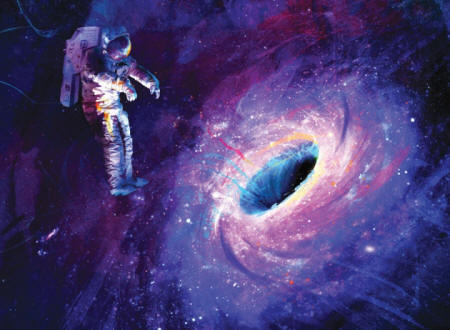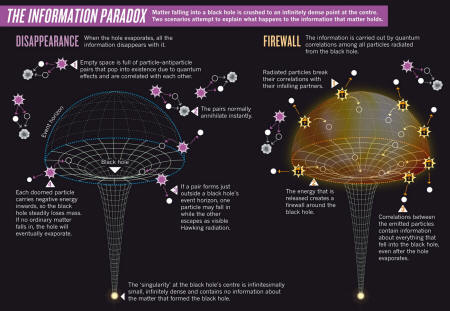|
from
Nature Website
Will an Astronaut who falls into a Black Hole
be Crushed or Burned to a
Crisp?
Free interview
In March 2012, Joseph Polchinski began to contemplate suicide - at least in mathematical form.
A string theorist at the Kavli Institute for Theoretical Physics in Santa Barbara, California, Polchinski was pondering what would happen to an astronaut who dived into a black hole.
Obviously, he would die. But how?
But eventually - after hours, days or even weeks if the black hole was big enough - he would begin to notice that gravity was tugging at his feet more strongly than at his head.
As his plunge carried him inexorably
downwards, the difference in forces would quickly increase and rip
him apart, before finally crushing his remnants into the black
hole's infinitely dense core.
In their account, quantum effects would
turn the event horizon into a seething maelstrom of particles.
Anyone who fell into it would hit a wall of fire and be burned to a
crisp in an instant.
Known as the equivalence principle, it
states in part that an observer falling in a gravitational field -
even the powerful one inside a black hole - will see exactly the
same phenomena as an observer floating in empty space. Without this
principle, Einstein's framework crumbles.
But this solution came with a huge
price. Physicists would have to sacrifice the other great pillar of
their science: quantum mechanics, the theory governing the
interactions between subatomic particles.
Steve Giddings, a quantum physicist at the UCSB, describes the situation as,
With that thought in mind, black-hole experts came together last month at CERN, Europe's particle-physics laboratory near Geneva, Switzerland, to grapple with the issue face to face.
They hoped to reveal the path towards a
unified theory of 'quantum gravity' that brings all the fundamental
forces of nature under one umbrella - a prize that has eluded
physicists for decades.
Fiery origins
Left in isolation, the holes will slowly
spew out thermal radiation - photons and other particles - and
gradually lose mass until they evaporate away entirely (see 'The
information paradox').
But Hawking's result was still startling - not least because the equations of general relativity say that black holes can only swallow mass and grow, not evaporate.
Down at this sub-sub-microscopic level, it is in constant turmoil, with pairs of particles and their corresponding antiparticles continually popping into existence before rapidly recombining and vanishing. Only in very delicate laboratory experiments does this submicroscopic frenzy have any observable consequences.
But when a particle-antiparticle pair appears just outside a black hole's event horizon, Hawking realized, one member could fall in before the two recombined, leaving the surviving partner to fly outwards as radiation.
The doomed particle would balance the
positive energy of the outgoing particle by carrying negative energy
inwards - something allowed by quantum rules. That negative energy
would then get subtracted from the black hole's mass, causing the
hole to shrink.
In principle, it should be possible to recover everything there is to know about the objects that fell in a black hole by measuring the quantum state of the radiation coming out.
But Hawking showed that it was not that
simple: the radiation coming out is random. Toss in a kilogram of
rock or a kilogram of computer chips and the result will be the
same. Watch the black hole even until it dies, and there would still
be no way to tell how it was formed or what fell in it.
Some, like Hawking, argued that the information truly vanishes when the black hole dies. If that contradicted quantum laws, then better laws needed to be found.
Others, like John Preskill, a quantum physicist at the California Institute of Technology in Pasadena, stuck by quantum mechanics.
The stalemate continued for the next two
decades, finding its most famous expression in 1997, when Preskill
publicly bet Hawking that information was not being lost, with the
winner to receive an encyclopedia of his choice.
Maldacena's insight built on an earlier proposal that any three-dimensional (3D) region of our Universe can be described by information encoded on its two-dimensional (2D) boundary,3-5 in much the same way that laser light can encode a 3D scene on a 2D hologram.
What Maldacena came up with was a concrete mathematical formulation 6 of the hologram idea that made use of ideas from superstring theory, which posits that elementary particles are composed of tiny vibrating loops of energy.
His model envisages a 3D universe containing strings and black holes that are governed only by gravity, bounded by a 2D surface on which elementary particles and fields obey ordinary quantum laws without gravity.
Hypothetical residents of the 3D space would never see this boundary because it is infinitely far away.
But that wouldn't matter: anything happening in the 3D universe could be described equally well by equations in the 2D universe, and vice versa.
This meant that even 3D black-hole evaporation could be described in the 2D world, where there is no gravity, where quantum laws reign supreme and where information can never be lost. And if information is preserved there, then it must also be preserved in the 3D world.
Somehow, information must be escaping from the black holes.
In 2004, Hawking publicly admitted that
he had been wrong, and gave Preskill a baseball encyclopedia to make
good on their bet.
There wasn't.
When Polchinski and his team set
themselves the task of clearing up that loose end in early 2012,
they soon stumbled on yet another paradox - the one that eventually
led them to the fatal firewall.
But in the mid-1990s, Leonard Susskind and
others realized that information could be encoded in the quantum
state of the radiation as a whole if the particles could somehow
have their states 'entangled' - intertwined in such a way that
measurements carried out on one will immediately influence its
partner, no matter how far apart they are.
For a particle to be emitted at all, it
has to be entangled with the twin that is sacrificed to the black
hole. And if Susskind and others were right, it also had to be
entangled with all the Hawking radiation emitted before it. Yet a
rigorous result of quantum mechanics dubbed 'the monogamy of
entanglement' says that one quantum system cannot be fully entangled
with two independent systems at once.
But there was a cost.
The energy generated by severing lots of twins would be enormous.
And that, in turn, violates the equivalence principle and its assertion that free-fall should feel the same as floating in empty space - impossible when the former ends in incineration.
So they posted a paper on the preprint server, arXiv, presenting physicists with a stark choice: either accept that firewalls exist and that general relativity breaks down, or accept that information is lost in black holes and quantum mechanics is wrong. 1
The paper rocked the physics community.
If Einstein's theory doesn't apply at
the event horizon, cosmologists would have to question whether it
fully applies anywhere.
So he turned to Susskind, one of the fathers of holography, to find it.
He posted a paper stating as much,8 before quickly retracting it, after further thought.
Since then, more than 40 papers have been posted on the topic in arXiv, but as yet, nobody has found a flaw in the team's logic.
A number of inventive solutions have been offered, however.
They considered whether an astronaut could ever detect the paradox with a real-world measurement. To do so, he or she would first have to decode a significant portion of the outgoing Hawking radiation, then dive into the black hole to examine the infalling particles.
The pair's calculations show that the radiation is so tough to decode that the black hole would evaporate before the astronaut was ready to jump in. 9
Giddings, however, argues that the firewall paradox requires a radical solution.
He has calculated that if the entanglement between the outgoing Hawking radiation and its infalling twin is not broken until the escaping particle has travelled a short distance away from the event horizon, then the energy released would be much less ferocious, and no firewall would be generated10. This protects the equivalence principle, but requires some quantum laws to be modified.
At the CERN meeting, participants were
tantalized by the possibility that Giddings' model could be tested:
it predicts that when two black holes merge, they may produce
distinctive ripples in space-time that can be detected by
gravitational-wave observatories on Earth.
Ironically, it is Preskill, the man who bet against Hawking's claim, who raised this alternative, at a workshop on firewalls at Stanford at the end of last year.
The reluctance to revisit Hawking's old argument is a sign of the immense respect that physicists have for Maldacena's dictionary relating gravity to quantum theory, which seemingly proved that information cannot be lost.
Maldacena is flattered that most physicists would back him in a straight-out fight against Einstein, although he believes it won't come to that.
The only consensus so far is that this problem will not go away any time soon.
During his talk, Polchinski fielded all proposed strategies for mitigating the firewall, carefully highlighting what he sees as their weaknesses.
References
|



